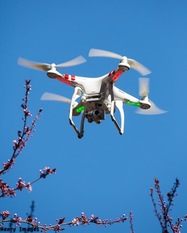
The FAA and its government partners are expanding research on ways to detect “rogue” drones around airports. The Federal Aviation Administration (FAA) and its government, industry and academia partners have joined forces to evaluate drone detection technology at John F. Kennedy International Airport (JFK) in New York.
Over the last two years, the FAA has received numerous reports from pilots and residents about unmanned aircraft systems – UAS, or “drones” – around some of the nation’s busiest airports, including JFK. “We face many difficult challenges as we integrate rapidly evolving UAS technology into our complex and highly regulated airspace,” said Marke “Hoot” Gibson, FAA Senior Advisor on UAS Integration. “This effort at JFK reflects everyone’s commitment to safety.”
Beginning May 2, the FAA conducted evaluations at JFK to study the effectiveness of a Federal Bureau of Investigation (FBI) UAS detection system in a commercial airport environment. Five different rotorcraft and fixed wing UAS participated in the evaluations, and about 40 separate tests took place.
The JFK evaluation involved extensive government inter-agency collaboration, and cooperation from industry and academia. The tests expanded on research performed earlier this year at Atlantic City International Airport.
In addition to the FAA and the FBI, the agencies combining forces in this research included the Department of Homeland Security (DHS), Department of Justice, Queens District Attorney’s Office and the Port Authority of New York and New Jersey. DHS and the FBI want to identify unauthorized UAS operators for law enforcement purposes, and the FAA’s mission is to provide a safe and efficient airport environment for both manned and unmanned air traffic.
“We applaud the FBI and FAA for their efforts to detect and track unmanned aerial systems (UAS),” said Thomas Bosco, Port Authority Aviation Director. “We look forward to supporting continued U.S. Government efforts to identify and deploy countermeasures to neutralize the threat posed by rogue UASs.”
The team evaluating the FBI’s detection system also included contributions from one of the six FAA-designated UAS test sites. The Griffiss International Airport test site in Rome, NY, provided expertise in planning the individual tests as well as the flight commander for the tests and two of the UAS used.
The FY 2016 Appropriations law mandates that the FAA continue research into detection of UAS in airport environments. The agency is continuing to formulate an inter-agency strategy to evaluate detection systems in a variety of airport environments.
SOURCE
Over the last two years, the FAA has received numerous reports from pilots and residents about unmanned aircraft systems – UAS, or “drones” – around some of the nation’s busiest airports, including JFK. “We face many difficult challenges as we integrate rapidly evolving UAS technology into our complex and highly regulated airspace,” said Marke “Hoot” Gibson, FAA Senior Advisor on UAS Integration. “This effort at JFK reflects everyone’s commitment to safety.”
Beginning May 2, the FAA conducted evaluations at JFK to study the effectiveness of a Federal Bureau of Investigation (FBI) UAS detection system in a commercial airport environment. Five different rotorcraft and fixed wing UAS participated in the evaluations, and about 40 separate tests took place.
The JFK evaluation involved extensive government inter-agency collaboration, and cooperation from industry and academia. The tests expanded on research performed earlier this year at Atlantic City International Airport.
In addition to the FAA and the FBI, the agencies combining forces in this research included the Department of Homeland Security (DHS), Department of Justice, Queens District Attorney’s Office and the Port Authority of New York and New Jersey. DHS and the FBI want to identify unauthorized UAS operators for law enforcement purposes, and the FAA’s mission is to provide a safe and efficient airport environment for both manned and unmanned air traffic.
“We applaud the FBI and FAA for their efforts to detect and track unmanned aerial systems (UAS),” said Thomas Bosco, Port Authority Aviation Director. “We look forward to supporting continued U.S. Government efforts to identify and deploy countermeasures to neutralize the threat posed by rogue UASs.”
The team evaluating the FBI’s detection system also included contributions from one of the six FAA-designated UAS test sites. The Griffiss International Airport test site in Rome, NY, provided expertise in planning the individual tests as well as the flight commander for the tests and two of the UAS used.
The FY 2016 Appropriations law mandates that the FAA continue research into detection of UAS in airport environments. The agency is continuing to formulate an inter-agency strategy to evaluate detection systems in a variety of airport environments.
SOURCE
 RSS Feed
RSS Feed